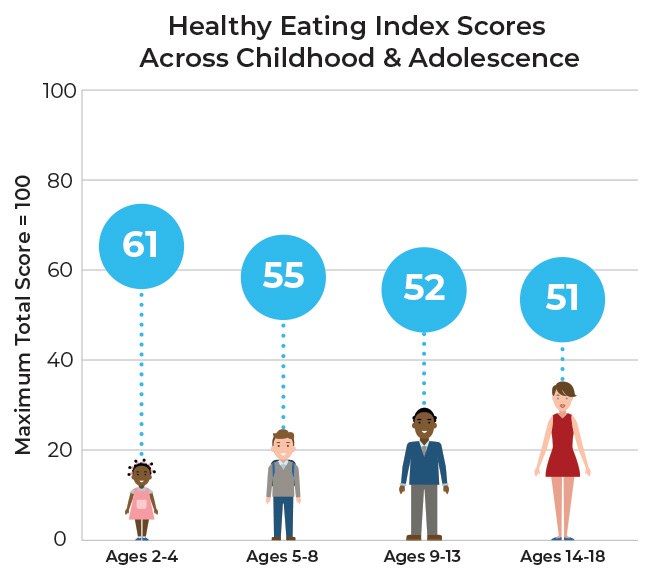Fueling a Lifetime of Health: Early Nutrition for Children’s Long-Term Wellbeing
 By Dr. Arianna Carughi,
By Dr. Arianna Carughi,
Scientific Advisory Board member
As parents we always want to give children the best chances for a long and healthy life. One way we can do this is to focus on their nutrition from the very beginning. Children go through a phenomenal growth and development phase during their growing years. Their body weight doubles many times over from the time that they are born. Nutrients provide their bodies’ building blocks, the energy with which to fuel growth and the essential vitamins and minerals that make the reactions necessary for growth to happen. Childhood is also a time where the immune system is fine tuning and is called upon to respond to some of its greatest challenges. It is also a time when cognitive skills and personalities are developing. Finally, we are learning more and more about the profound impact that early nutrition has on health later in life. We know now that health decisions parents make today can determine not only whether children are meeting nutrient needs to support healthy growth and development, but also if they will live to 60, 80 or beyond.
It is not surprising then that for the first time since 1980 the 2020-2025 Dietary Guidelines for Americans feature dietary recommendation for every stage of early life including infants, toddlers, children, and teens. They define a healthy diet as one that meets the body’s requirements for essential nutrients and health promoting components, not only to support health at that point in time, but also to support health in the later life stages and even future generations.1
So, what is the backbone of a healthy diet for the earlier life stages? Just like for adults, it is one that consists of plenty of vegetables, including dark green, orange, and yellow ones; one that is rich in fruits, legumes, nuts, whole grains, low- or non-fat dairy products, lean meats and poultry, and seafood.2 A healthy diet is low in saturated fats, processed meats, salt, added sugar and sugar sweetened foods and refined grains. A healthy diet should focus on nutrient-dense foods and stay within calorie limits.
Current intakes show that from an early age, dietary patterns fall short of meeting recommendations. Scientists use the Healthy Eating Index (HEI) to measure diet quality and to assess how well a set of foods aligns with key dietary guidelines. The latest Dietary Guidelines discusses results from the 2015-2016 National Health and Nutrition Examination Survey (NHANES), which shows that the diet of children ages 2 through 4 has a HEI score of 61 out of 100. Not great… grade wise, that would be a D. Most worrisome is that HEI Scores decline throughout childhood with scores for teens approximately 10 points lower than those for young children (Figure 1).
- More than 80% of children and teens have a diet that is low in fruits and vegetables.
- Most do not meet whole grain and seafood recommendations.
- Only one third of teens and two thirds of children drink milk on a given day.
At the same time diets exceed limits for sodium, saturated fats and added sugars. So, there is a lot of room for improvement!
Figure 1. Healthy Eating Index Scores Across Childhood and Adolescence1
What can we do? Follow the guidelines of healthy eating and stock up on healthy food. Kids, especially younger ones, will eat mostly what is available at home. Encourage them to consume a wide variety of colorful fruits and vegetables and tell them why it is important for them. One of the most important responsibilities we have as parents is to support our children in developing healthy eating patterns. Instilling good eating habits from a young age can help prevent childhood obesity, improve, or maintain their physical health, and even positively impact their mental health. Also encourage them to keep physically active. Just like choosing the right foods, incorporating physical activity into our day by staying active is part of the recipe for keeping healthy. Good nutrition and plenty of exercise are the building blocks for strong growth, healthy development, and lifelong wellbeing for children. Finally, we should make sure to eat healthy, wholesome foods and get plenty of exercise ourselves. We should be role models for healthy living!
Nutrition and good health come hand in hand: good nutrition keeps our children and teens healthy and may even lengthen their lives. In many ways, childhood, from infancy through teen years, is the only window of opportunity we have to significantly impact many aspects of adult health. It is not easy these days to make sure that our kids eat healthy diets that satisfy the increasing demand for nutrients. NeoLife provides responsible, high-quality products that can help us attain this goal throughout our children’s life. Liqui-Vite for the very youngest, Vita-Square and Vita-Gard once they can safely chew and swallow and Formula IV, NeoLifeShake, Tré and Cal-Mag as they get older can help ensure that our children and teens’ diet provide an abundance of essential nutrients and protective food components their young bodies need!
|
Liqui-Vite The perfect liquid supplement for infants and toddlers provides vitamins and key nutrients for very youngest including choline, inositol, and whole food flavonoids and carotenoids.* |
|
|
Vita-Gard & Vita-Squares Designed to fill nutritional gaps and build a solid foundation of health, theses supplements help assure that your children receive the vitamins, minerals, lipids, and sterols, plus a broad spectrum of whole-food antioxidants they need.* |
|
|
NeoLifeShake High quality protein to ensure your children and teens are receiving the building blocks they need for their growing bodies. This biologically complete protein shake comes with 25 essential vitamins and minerals and provides wholesome nutrition to support their very active lives.* |
References:
-
- U.S. Department of Agriculture and U.S. Department of Health and Human Services. Dietary Guidelines for Americans, 2020-2025. 9th Edition.
- U.S. Department of Agriculture. ChooseMyPlate.gov Website. Washington, DC.






















